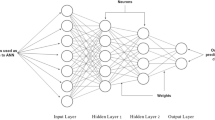Abstract
Electricity load forecasting plays a vital role in planning power systems in any region. A reliable forecast model is essential to implement an affordable and sustainable energy system. Several studies reveal that weather conditions in a region have a strong relation with energy generation. This paper presents deep learning models to forecast electricity demand considering both energy generation and weather factors in a region. The deep learning models consist of LSTM, stacked LSTM, and CNN-LSTM. In addition, ARIMAX forecasting is applied to compare the effectiveness of the deep learning models. With RRMSE of 1.528%, the CNN-LSTM model outperforms not only the other LSTM models but also ARIMAX confirming the usability of the proposed model.
Access this chapter
Tax calculation will be finalised at checkout
Purchases are for personal use only
Similar content being viewed by others
References
Son H, Kim C (2017) Short-term forecasting of electricity demand for the residential sector using weather and social variables. Resour Conserv Recycl 123:200–207. https://doi.org/10.1016/J.RESCONREC.2016.01.016
Zhao GY, Liu ZY, He Y, Cao HJ, Guo YB (2017) Energy consumption in machining: classification, prediction, and reduction strategy. Energy 133:142–157. https://doi.org/10.1016/J.ENERGY.2017.05.110
Dehalwar V, Kalam A, Kolhe ML, Zayegh A (2017) Electricity load forecasting for urban area using weather forecast information. In: 2016 IEEE International Conference on Power and Renewable Energy, ICPRE 2016, pp 355–359. https://doi.org/10.1109/ICPRE.2016.7871231
Bedi J, Toshniwal D (2018) Empirical mode decomposition based deep learning for electricity demand forecasting. IEEE Access 6:49144–49156. https://doi.org/10.1109/ACCESS.2018.2867681
Yukseltan E, Yucekaya A, Bilge AH (2020) Hourly electricity demand forecasting using Fourier analysis with feedback. Energ Strat Rev 31:100524. https://doi.org/10.1016/J.ESR.2020.100524
Biswas MAR, Robinson MD, Fumo N (2016) Prediction of residential building energy consumption: a neural network approach. Energy 117:84–92. https://doi.org/10.1016/J.ENERGY.2016.10.066
Zhao HX, Magoulès F (2012) A review on the prediction of building energy consumption. Renew Sustain Energy Rev 16:3586–3592. https://doi.org/10.1016/J.RSER.2012.02.049
Al-Musaylh MS, Deo RC, Adamowski JF, Li Y (2018) Short-term electricity demand forecasting with MARS, SVR and ARIMA models using aggregated demand data in Queensland, Australia. Adv Eng Informatics 35:1–16. https://doi.org/10.1016/J.AEI.2017.11.002
Hamzaçebi C (2016) Primary energy sources planning based on demand forecasting: the case of Turkey. J Energy Southern Afr 27:2–10. https://doi.org/10.17159/2413-3051/2016/V27I1A1560
Guo H, Chen Q, Xia Q, Kang C, Zhang X (2018) A monthly electricity consumption forecasting method based on vector error correction model and self-adaptive screening method. Int J Electr Power Energy Syst 95:427–439. https://doi.org/10.1016/J.IJEPES.2017.09.011
Li R, Jiang P, Yang H, Li C (2020) A novel hybrid forecasting scheme for electricity demand time series. Sustain Cities Soc 55:102036. https://doi.org/10.1016/J.SCS.2020.102036
Zhang G, Guo J (2020) A novel method for hourly electricity demand forecasting. IEEE Trans Power Syst 35:1351–1363. https://doi.org/10.1109/TPWRS.2019.2941277
Chandramitasari W, Kurniawan B, Fujimura S (2019) Building deep neural network model for short term electricity consumption forecasting. In: Proceeding—2018 international symposium on advanced intelligent informatics: revolutionize intelligent informatics spectrum for humanity, SAIN 2018, pp 43–48. https://doi.org/10.1109/SAIN.2018.8673340
Hourly energy demand generation and weather|Kaggle. https://www.kaggle.com/nicholasjhana/energy-consumption-generation-prices-and-weather. Last accessed 2021/08/28
Burt S (2007) The highest of the highs … extremes of atmospheric pressure in the British Isles, Part 2—the most intense anticyclones. Weather 62:31–41. https://doi.org/10.1002/wea.35
Fujita Scale—Tornado Damage Scale. factsjustforkids.com
Dickey DA, Fuller WA (2012) Distribution of the estimators for autoregressive time series with a unit root. https://doi.org/10.1080/01621459.1979.10482531. 74:427–431 (2012). https://doi.org/10.1080/01621459.1979.10482531
Kwiatkowski D, Phillips PCB, Schmidt P, Shin Y (1992) Testing the null hypothesis of stationarity against the alternative of a unit root: how sure are we that economic time series have a unit root? J Econometrics 54:159–178. https://doi.org/10.1016/0304-4076(92)90104-Y
Granger CWJ (1969) Investigating causal relations by econometric models and cross-spectral methods. Econometrica 37:424. https://doi.org/10.2307/1912791
Greff K, Srivastava RK, Koutnik J, Steunebrink BR, Schmidhuber J (2017) LSTM: a search space odyssey. IEEE Trans Neural Netw Learn Syst 28:2222–2232. https://doi.org/10.1109/TNNLS.2016.2582924
Hermans M, Schrauwen B (2013) Training and analysing deep recurrent neural networks. In: Advances in neural information processing systems, vol 26
Kim TY, Cho SB (2019) Predicting residential energy consumption using CNN-LSTM neural networks. Energy 182:72–81. https://doi.org/10.1016/J.ENERGY.2019.05.230
Fan J, Shan R, Cao X, Li P (2009) The analysis to tertiary-industry with ARIMAX model. J Math Res 1:156
Akaike H (1998) Information theory and an extension of the maximum likelihood principle, pp 199–213. https://doi.org/10.1007/978-1-4612-1694-0_15
Chai T, Draxler RR (2014) Root mean square error (RMSE) or mean absolute error (MAE)?—Arguments against avoiding RMSE in the literature. Geosci Model Dev 7:1247–1250. https://doi.org/10.5194/GMD-7-1247-2014
Prasad R, Deo RC, Li Y, Maraseni T (2017) Input selection and performance optimization of ANN-based streamflow forecasts in the drought-prone Murray Darling Basin region using IIS and MODWT algorithm. Atmos Res 197:42–63. https://doi.org/10.1016/J.ATMOSRES.2017.06.014
Mohammadi K, Shamshirband S, Anisi MH, Amjad Alam K, Petković D (2015) Support vector regression based prediction of global solar radiation on a horizontal surface. Energy Convers Manage 91:433–441. https://doi.org/10.1016/J.ENCONMAN.2014.12.015
Author information
Authors and Affiliations
Corresponding author
Editor information
Editors and Affiliations
Rights and permissions
Copyright information
© 2022 The Author(s), under exclusive license to Springer Nature Singapore Pte Ltd.
About this paper
Cite this paper
Zaman, S., Nayeem, M., Tatrapi, R., Ripon, S. (2022). Deep Learning Approach for Electricity Load Forecasting Using Multivariate Time Series Data. In: Skala, V., Singh, T.P., Choudhury, T., Tomar, R., Abul Bashar, M. (eds) Machine Intelligence and Data Science Applications. Lecture Notes on Data Engineering and Communications Technologies, vol 132. Springer, Singapore. https://doi.org/10.1007/978-981-19-2347-0_62
Download citation
DOI: https://doi.org/10.1007/978-981-19-2347-0_62
Published:
Publisher Name: Springer, Singapore
Print ISBN: 978-981-19-2346-3
Online ISBN: 978-981-19-2347-0
eBook Packages: Intelligent Technologies and RoboticsIntelligent Technologies and Robotics (R0)




